- Tips for Speeding Up Tomato Ripening on the Vine
- 1. Pruning
- 2. Pinching
- 3. Reduce Watering
- 4. Increase Temperature
- 5. Use Ethylene Gas
- Optimal Sun Exposure
- Pruning and Trimming Techniques
- 1. Remove Suckers
- 2. Prune Lower Leaves
- 3. Trim Excessive Foliage
- 4. Support with Stakes or Cages
- 5. Prune Diseased or Damaged Portions
- Proper Watering Schedule
- 1. Water deeply and infrequently
- 2. Water in the morning
- 3. Use a drip irrigation system or soaker hose
- 4. Monitor soil moisture
- 5. Adjust watering frequency based on weather conditions
- Nutrient-Rich Soil
- Warmth and Shelter
- Using Fertilizers and Plant Boosters
- 1. Choose the Right Fertilizer
- 2. Apply Fertilizer at the Right Time
- 3. Use Organic Boosters
- 4. Foliar Feeding
- 5. Avoid Overfeeding
- Protection from Pests and Diseases
- 1. Choose disease-resistant varieties
- 2. Rotate your crops
- 3. Provide proper spacing
- 4. Mulch your plants
- 5. Monitor and control pests
- Harvesting at the Right Time
- 1. Look for the right color
- 2. Feel the tomato
- 3. Check the stem
- 4. Smell the tomato
- 5. Consider the days to maturity
- “Question-Answer”
- How can I speed up the ripening of tomatoes on the vine?
- What are the best nutrients to promote tomato ripening?
- How does pruning help in speeding up tomato ripening?
- What is ethylene gas and how can it help in tomato ripening?
- How can covering the tomato plants speed up ripening?
- Are there any other tips to speed up tomato ripening?
- Can unripened tomatoes be ripened off the vine?
- “Video” Get Tomatoes to Ripen Faster on the Vine – How to Ripen Green Tomatoes
Tomatoes are a staple in many gardens, but waiting for them to ripen can be a test of patience. Luckily, there are several tips and tricks you can use to speed up the ripening process and enjoy delicious, homegrown tomatoes sooner. By taking a few extra steps and providing optimal conditions for your tomatoes, you can help them reach their full flavor and juiciness faster.
One of the first steps you can take to speed up the ripening process is to provide your tomatoes with plenty of sunlight. Tomatoes need at least 6-8 hours of direct sunlight each day to ripen properly. If your tomato plants are not receiving enough sun, consider moving them to a sunnier location or using reflective materials to redirect light onto the plants. This will help the tomatoes receive the full spectrum of sunlight they need to ripen.
In addition to sunlight, temperature plays a crucial role in tomato ripening. Tomatoes prefer warm temperatures between 70-80 degrees Fahrenheit (21-27 degrees Celsius). If the weather is consistently below this range, consider using a plastic or fabric cover to create a mini greenhouse effect around your plants. This will help trap heat and create a warmer environment for the tomatoes to ripen.
Another tip to speed up tomato ripening is to avoid overwatering your plants. While tomatoes need regular watering to stay healthy, overwatering can slow down the ripening process. Excess water can cause the fruits to become too plump and delay the onset of ripening. Make sure to water your tomato plants evenly and avoid saturating the soil. This will help the plants focus their energy on ripening the fruits rather than excessive growth.
Lastly, you can try using ethylene-producing fruits to accelerate tomato ripening. Tomatoes naturally produce ethylene gas, which triggers the ripening process. By placing a ripe banana or apple near your tomatoes, you can increase the ethylene levels in the surrounding environment and speed up the ripening. Just make sure to check on the fruits regularly and remove any decaying or moldy pieces.
By following these tips, you can help your tomatoes ripen faster and enjoy a bountiful harvest. Remember to be patient and monitor your plants closely for any signs of stress or disease. With a little extra care and attention, you’ll be savoring the delicious taste of homegrown tomatoes in no time.
Tips for Speeding Up Tomato Ripening on the Vine
1. Pruning
Regularly prune your tomato plants by removing any excess foliage, especially around the center of the plant. This allows more sunlight to reach the tomatoes and increases air circulation, which can help speed up the ripening process.
2. Pinching
Pinch off any suckers that develop in the leaf axils of the tomato plant. These suckers divert energy away from the developing fruits, so removing them can help the tomatoes ripen faster.
3. Reduce Watering
Tomatoes need consistent moisture, but over-watering can slow down the ripening process. Reduce the amount of water you give to your tomato plants, especially as the fruits start to ripen. This will encourage the plant to focus its energy on ripening the tomatoes rather than growing new foliage.
4. Increase Temperature
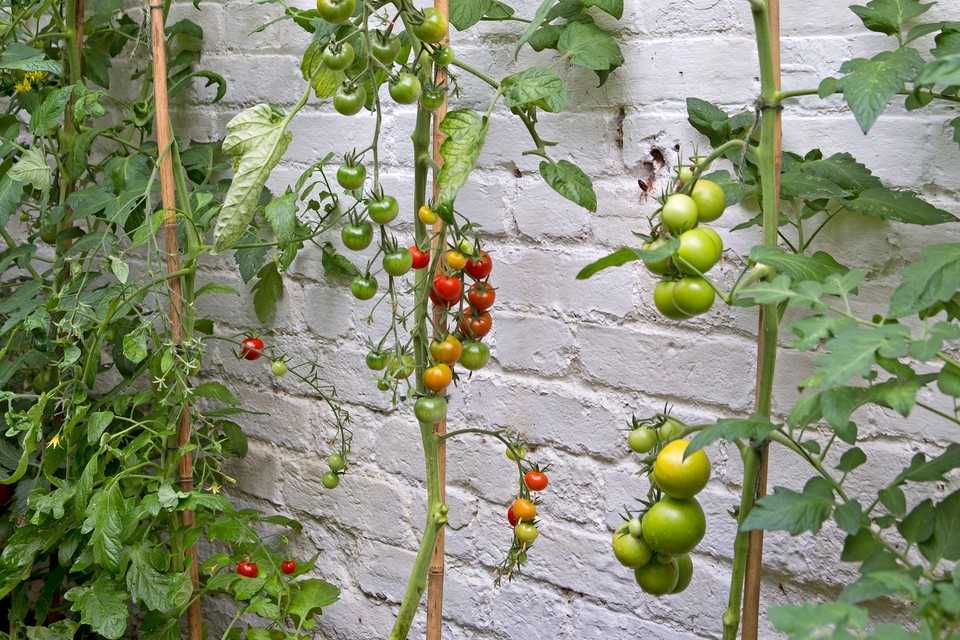
Tomatoes ripen faster in warm temperatures. If you are growing tomatoes in a greenhouse or a container, consider using a heater or placing the container in a sunny and warm spot. Increasing the temperature around the tomato plants can help speed up the ripening process.
5. Use Ethylene Gas
Introduce ethylene gas near your tomato plants to promote ripening. Ethylene is a natural plant hormone that triggers the ripening process. You can place a ripe banana or apple near the tomato plants or use a commercial ethylene gas product to stimulate ripening.
By following these tips, you can help speed up the ripening process of tomatoes on the vine, allowing you to enjoy delicious homegrown tomatoes sooner.
Optimal Sun Exposure
Tomatoes need plenty of sunlight to ripen properly on the vine. Adequate sun exposure helps in the process of photosynthesis, which is essential for the production of sugars and pigments that give tomatoes their rich color and sweet taste. Here are some tips for ensuring optimal sun exposure for your tomatoes:
- Choose a sunny location: Plant your tomatoes in an area of your garden that receives at least 6-8 hours of direct sunlight per day. Avoid planting them in shady spots or areas with too much shade from nearby trees or buildings.
- Prune surrounding plants: If there are any overhanging trees or plants that are blocking sunlight from reaching your tomato plants, trim them back or prune them to allow more light to reach the tomatoes.
- Rotate the plants: If you have multiple tomato plants, consider rotating them every few weeks to ensure that each plant gets equal exposure to the sun. This will help promote even ripening of all the tomatoes in your garden.
- Provide support for vertical growth: If you are growing indeterminate varieties of tomatoes that tend to grow tall, use stakes or cages to support the plants and keep them upright. This will help ensure that the leaves and fruits are exposed to maximum sunlight.
- Monitor and adjust as needed: Keep an eye on your plants throughout the day and assess if they are receiving enough sunlight. If necessary, move potted tomatoes to sunnier spots or adjust stakes or cages to maximize sun exposure.
By following these tips, you can help your tomatoes receive the optimal sun exposure they need to ripen fully and develop their delicious flavors.
Pruning and Trimming Techniques
Pruning and trimming tomato plants can help speed up the ripening process by redirecting the plant’s energy towards the fruits. Here are some techniques to consider:
1. Remove Suckers
Suckers are the small shoots that grow in the leaf axils of tomato plants. Removing these suckers helps redirect the plant’s energy towards the main stem and fruit production. Use your fingers or pruning shears to pinch or cut off the suckers when they are small (around 1-2 inches long).
2. Prune Lower Leaves
As the tomato plants grow, some of the lower leaves may turn yellow or wither. These leaves often do not receive enough sunlight and can become a breeding ground for pests and diseases. Prune these lower leaves to improve air circulation and redirect energy towards fruit ripening.
3. Trim Excessive Foliage
Tomato plants can sometimes develop an excessive amount of foliage, which can shade the fruits and slow down ripening. Remove some of the excessive leaves to allow more sunlight to reach the fruits and enhance the ripening process.
4. Support with Stakes or Cages
Proper support for tomato plants can help improve air circulation, reduce disease risk, and aid in the ripening process. Use stakes or cages to support the plants and keep them upright. This ensures that the fruits are exposed to more sunlight and air, promoting faster ripening.
5. Prune Diseased or Damaged Portions
If you notice any diseased or damaged branches or fruits, promptly prune them to prevent the spread of diseases and to redirect the plant’s energy towards healthy growth and ripening. This will help ensure that the remaining fruits ripen efficiently.
Remember, while pruning and trimming can help with the ripening process, it’s important not to remove too much foliage, as leaves provide energy for the plant through photosynthesis. Find a balance between removing excessive foliage and maintaining enough leaves for healthy growth.
Proper Watering Schedule
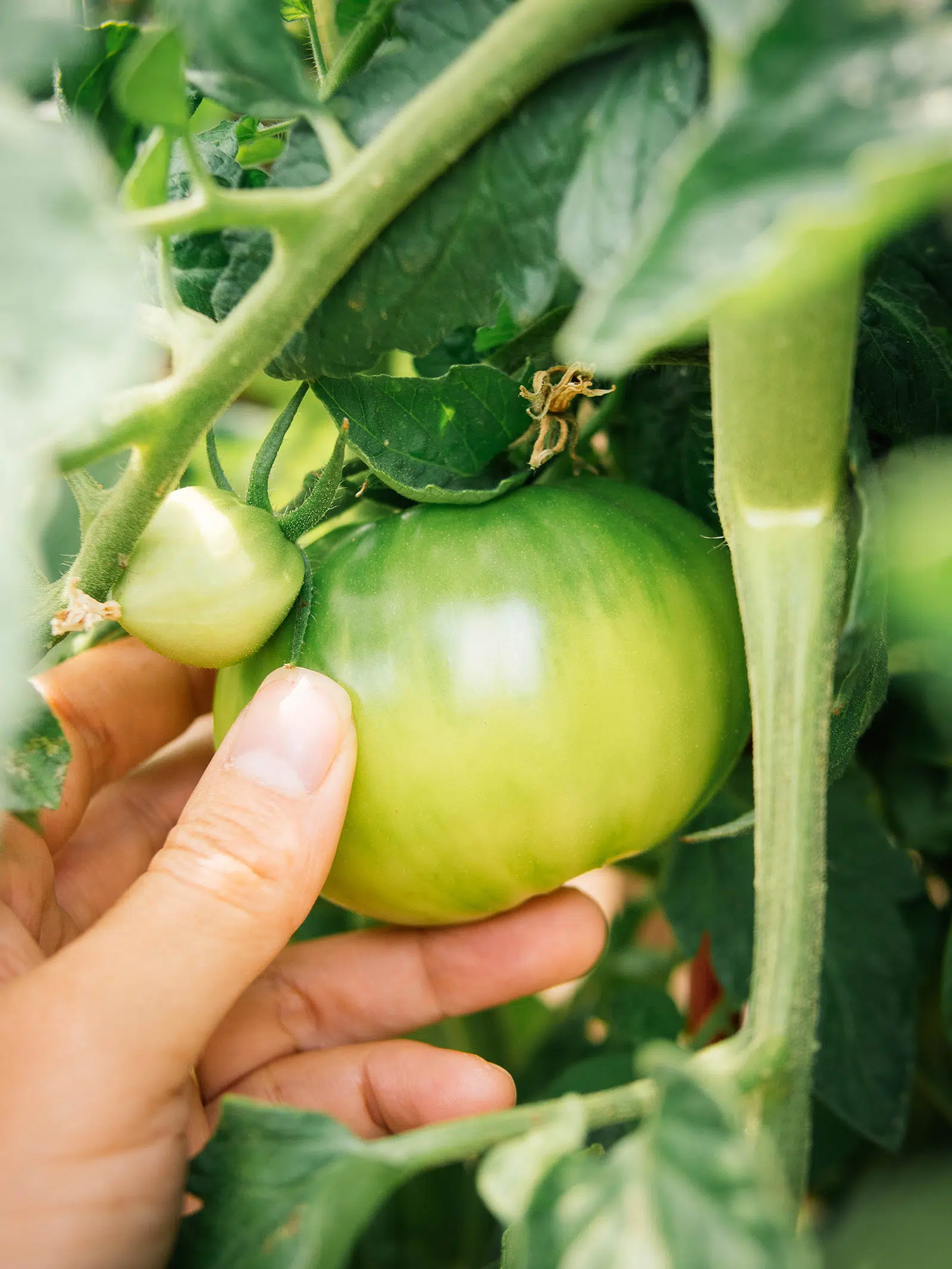
Consistent and appropriate watering is crucial for speeding up tomato ripening on the vine. Tomatoes require an adequate amount of water to grow, develop, and ripen properly. However, overwatering or underwatering can negatively impact the ripening process. Follow these tips to establish a proper watering schedule for your tomato plants:
1. Water deeply and infrequently

Instead of giving your tomato plants a light sprinkle of water every day, it is better to water deeply and infrequently. This encourages the roots to grow deeper and establish a strong, extensive root system.
2. Water in the morning
Watering your tomato plants in the morning allows the leaves and fruit to dry off quickly and reduces the risk of fungal diseases. Avoid watering in the late afternoon or evening when the plants will remain wet for a longer period.
3. Use a drip irrigation system or soaker hose
A drip irrigation system or soaker hose is ideal for watering tomato plants as it provides a slow, consistent water supply directly to the roots. This helps prevent water from splashing onto the foliage, which can also lead to disease.
4. Monitor soil moisture
Regularly check the soil moisture around your tomato plants. Stick your finger about an inch into the soil; if it feels dry, it’s time to water. If it feels moist, hold off on watering until it dries out a bit.
5. Adjust watering frequency based on weather conditions
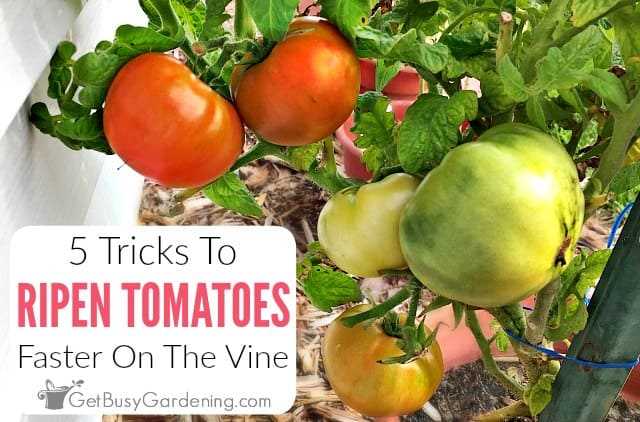
During hot and dry weather, tomato plants may require more frequent watering. On the other hand, during cooler and rainy periods, reduce the frequency of watering to prevent overwatering and excessive moisture in the soil.
By following these tips and establishing a proper watering schedule, you can help speed up the tomato ripening process and enjoy delicious homegrown tomatoes in no time!
Nutrient-Rich Soil
Having nutrient-rich soil is crucial for speeding up the ripening process of tomatoes on the vine. When tomatoes have access to the right nutrients, they are able to grow and mature more quickly.
Here are some tips for ensuring your soil is nutrient-rich:
- Organic Matter: Add compost or well-rotted manure to your soil to increase its nutrient content. This will provide a steady supply of nutrients to your tomato plants throughout the growing season.
- Fertilizer: Use a balanced organic fertilizer that contains a mix of nitrogen, phosphorus, and potassium. These essential nutrients will promote healthy growth and fruit formation.
- Microorganisms: Encourage the growth of beneficial microorganisms in your soil by using organic mulches and avoiding the use of chemical pesticides. These microorganisms help break down organic matter and release nutrients that are readily available to your tomato plants.
- pH Levels: Test the pH level of your soil and adjust it accordingly. Tomatoes prefer slightly acidic soil with a pH level between 6.0 and 6.8. If the pH is too high or too low, it can affect the plant’s ability to absorb nutrients.
Benefits of Nutrient-Rich Soil:
- Increased Yield: Plants grown in nutrient-rich soil are healthier and more productive. They are able to produce more tomatoes, leading to a higher yield.
- Improved Flavor: Tomatoes grown in nutrient-rich soil tend to have better flavor and quality. The nutrients in the soil enhance the natural taste of the tomatoes.
- Reduced Pest and Disease Problems: Strong and healthy tomato plants are more resistant to pests and diseases. Nutrient-rich soil helps strengthen the plants’ immune systems and make them less vulnerable to attacks.
- Quicker Ripening: When tomatoes have access to the right balance of nutrients, they can ripen faster on the vine. This means you can enjoy your homegrown tomatoes sooner!
Warmth and Shelter
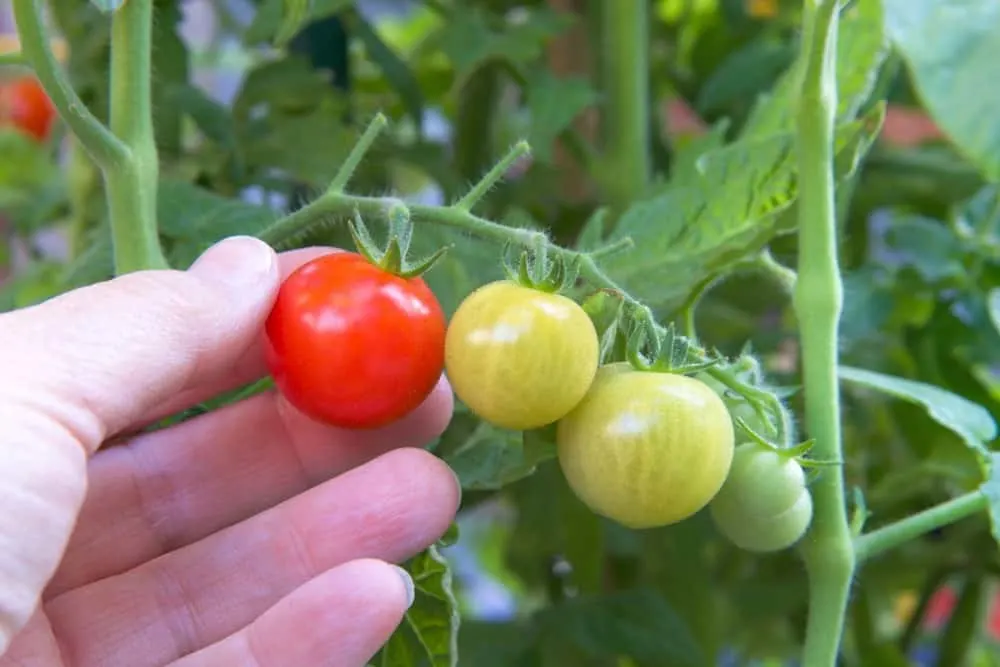
A warm and sheltered environment is crucial for speeding up tomato ripening on the vine. Here are some tips to create the right conditions:
- Choose a sunny location: Tomatoes thrive in full sun, so choose a location in your garden that receives at least 6 to 8 hours of direct sunlight each day. This will help increase the temperature around the plants and aid in ripening.
- Protect from wind: Strong winds can damage tomato plants and hinder ripening. Consider using a windbreak, such as a fence or a row of tall plants, to shield your tomato plants from strong gusts.
- Use mulch: Mulching around your tomato plants can help retain heat in the soil and create a warm microclimate. Apply a layer of organic mulch, such as straw or wood chips, around the base of the plants to help trap heat and keep the soil warm.
- Consider using cloches or row covers: Placing cloches or row covers over your tomato plants can provide extra warmth and shelter. These protective covers also help trap heat and create a miniature greenhouse effect, which can speed up ripening.
- Utilize hoop houses or greenhouses: If you have access to a hoop house or a greenhouse, consider growing your tomatoes inside. These structures provide excellent insulation and can significantly increase the temperature around your plants, leading to faster ripening.
By creating a warm and sheltered environment for your tomato plants, you can help accelerate the ripening process and enjoy ripe tomatoes earlier in the season.
Using Fertilizers and Plant Boosters
1. Choose the Right Fertilizer
Using the right fertilizer can significantly speed up the ripening process of tomatoes on the vine. Look for a fertilizer that is high in phosphorus (P), as it promotes fruit development and ripening. A balanced fertilizer with a ratio of 5-10-5 or 10-20-10 is ideal for boosting tomato ripening.
2. Apply Fertilizer at the Right Time
It is crucial to apply fertilizer at the right time to maximize its effect on ripening tomatoes. Start applying fertilizer when the first tomatoes are about pea-sized. Spread the fertilizer evenly around the base of the plants, avoiding direct contact with the stems or leaves. Water the plants well after applying the fertilizer to ensure it reaches the roots.
3. Use Organic Boosters
In addition to traditional fertilizers, organic boosters can also help speed up tomato ripening. Compost, manure, and bone meal are excellent organic options. These boosters provide important nutrients and improve soil fertility, resulting in healthier plants and faster ripening tomatoes.
4. Foliar Feeding
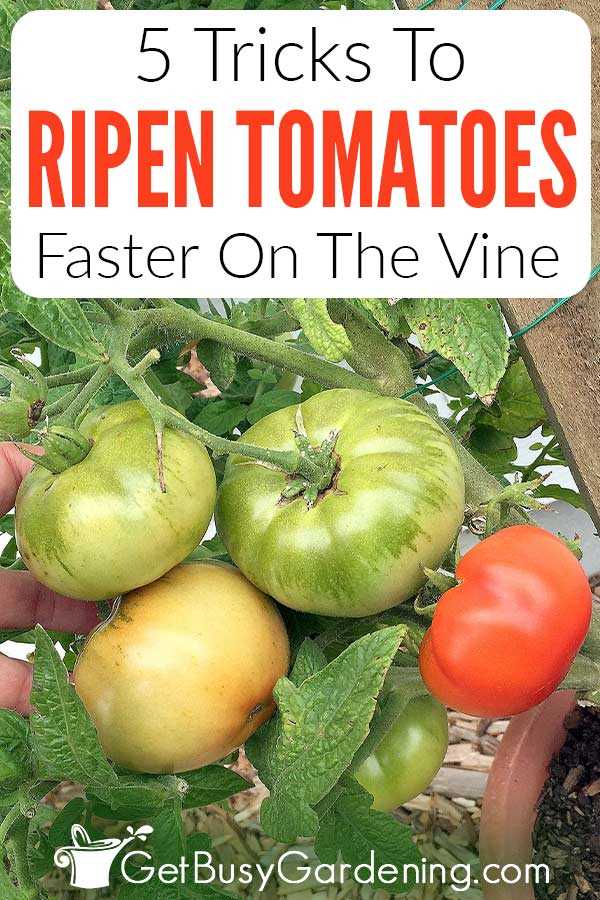
Foliar feeding involves spraying a fertilizer solution directly onto the leaves. This method allows the plants to absorb nutrients more efficiently, promoting faster ripening. Dilute a liquid fertilizer according to the package instructions and use a sprayer to apply it to the tomato leaves. Be sure to do this in the early morning or late afternoon to avoid leaf burn.
5. Avoid Overfeeding
While fertilizers and plant boosters can speed up tomato ripening, it’s essential not to overfeed your plants. Excessive fertilizer application can lead to nutrient imbalances and even damage the plants. Follow the instructions on the fertilizer packaging and avoid applying more than the recommended amount.
- Choose the right fertilizer
- Apply fertilizer at the right time
- Use organic boosters
- Foliar feeding
- Avoid overfeeding
By following these tips and using appropriate fertilizers and plant boosters, you can accelerate the ripening process of tomatoes on the vine, ensuring a bountiful and tasty harvest.
Protection from Pests and Diseases
Pests and diseases can pose a threat to your tomato plants and hinder their ripening process. It is essential to take preventive measures and protect your plants to ensure a healthy and abundant harvest. Here are some tips to protect your tomato plants from pests and diseases:
1. Choose disease-resistant varieties
When selecting tomato varieties for your garden, opt for disease-resistant varieties. These varieties are bred to be more resistant to common tomato diseases such as blight, wilt, and leaf spot. Look for varieties labeled with resistance codes such as VFN, which indicates resistance to verticillium wilt, fusarium wilt, and nematodes.
2. Rotate your crops
Rotate your tomato crops each year to reduce the risk of diseases building up in the soil. Avoid planting tomatoes in the same spot for consecutive years, as this can create a favorable environment for pests and diseases to thrive. Rotate your plants with crops from different botanical families to break the disease cycle.
3. Provide proper spacing
Ensure that your tomato plants are properly spaced to maximize air circulation. Crowded plants can create a humid microclimate, which can encourage the development of diseases such as blight and powdery mildew. Follow the spacing recommendations for the variety you are growing to prevent overcrowding.
4. Mulch your plants
Apply a layer of organic mulch, such as straw or wood chips, around your tomato plants. Mulching helps suppress weed growth and maintain soil moisture, but it can also act as a barrier against soil-borne diseases. It prevents soil splashing onto the leaves, reducing the risk of diseases spreading.
5. Monitor and control pests
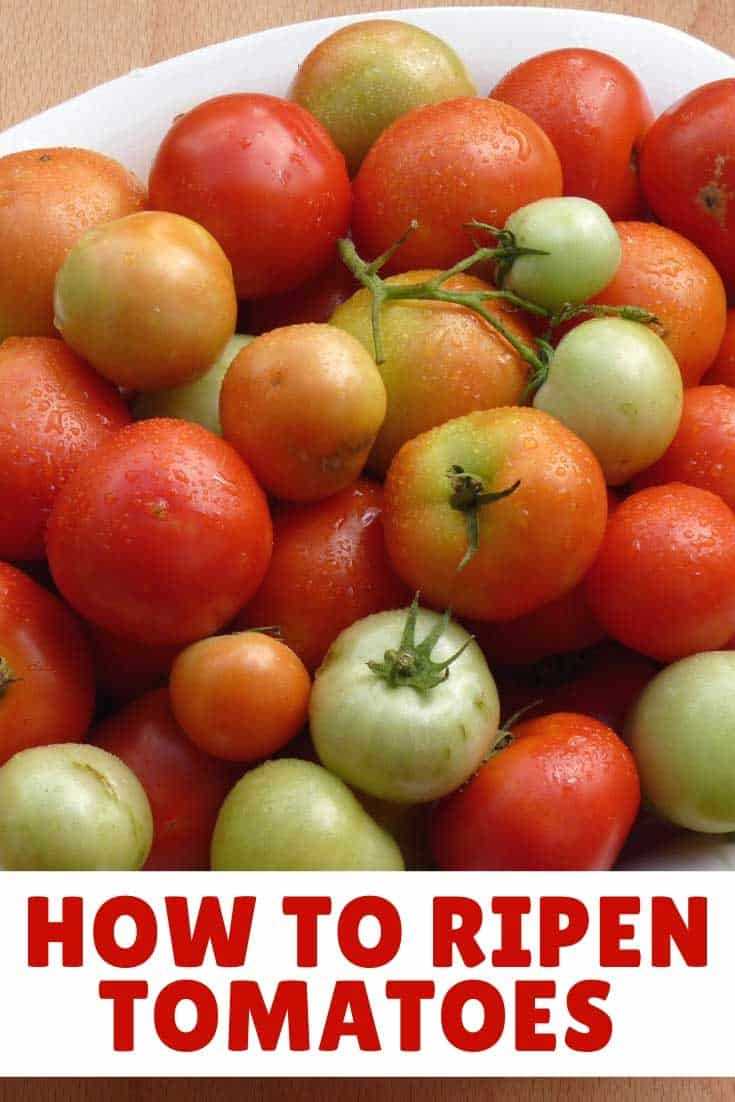
Regularly inspect your tomato plants for signs of pest infestation and take appropriate measures to control them. Common tomato pests include aphids, whiteflies, and tomato hornworms. Use organic pest control methods whenever possible, such as handpicking pests or using insecticidal soap or neem oil.
By implementing these protection measures, you can minimize the risk of pests and diseases affecting your tomato plants, allowing them to ripen fully on the vine and ensuring a successful harvest.
Harvesting at the Right Time
1. Look for the right color
When tomatoes are ripe, their color will change depending on the variety. For example, red tomatoes will turn a deep shade of red, while yellow tomatoes will turn a vibrant yellow color. Pay close attention to the color of the tomato and make sure it matches the typical ripeness color for that variety.
2. Feel the tomato
Gently squeeze the tomato to determine if it is ripe. A ripe tomato will feel firm but not too hard. It should have a slight give when you apply gentle pressure. However, if the tomato feels too soft or mushy, it may be overripe and not ideal for harvesting.
3. Check the stem
Inspect the stem of the tomato to ensure it is fully attached and green. If the stem is starting to turn brown or detach from the fruit, it may be an indication that the tomato is starting to deteriorate. Harvest tomatoes with a green, firmly attached stem for optimal freshness.
4. Smell the tomato
Ripe tomatoes will have a strong, sweet aroma. Take a sniff of the tomato near the stem and see if you can detect a pleasant fragrance. If the tomato lacks smell or has a sour odor, it may not be fully ripe yet, so consider leaving it on the vine for a little longer.
5. Consider the days to maturity
Refer to the seed packet or plant tag for the recommended days to maturity for your tomato variety. While the color and feel of the tomato are important indicators, knowing the estimated maturity timeline can help guide your harvesting decision. Harvesting too early may result in tasteless tomatoes, while waiting too long may lead to overripe or spoiled fruit.
“Question-Answer”
How can I speed up the ripening of tomatoes on the vine?
There are several methods you can try to speed up the ripening of tomatoes on the vine. First, you can give the plants a boost of nutrients, such as phosphorus and potassium, which are known to promote fruit ripening. You can also prune the plant to redirect its energy to ripening the existing tomatoes. Additionally, you can try using a ripening agent, such as ethylene gas, which can accelerate the ripening process. Finally, you can try covering the plants with a clear plastic or fabric cover to create a greenhouse effect and trap heat, which can help speed up the ripening process.
What are the best nutrients to promote tomato ripening?
Phosphorus and potassium are the best nutrients to promote tomato ripening. Phosphorus is essential for energy transfer and cell division, which are important for the ripening process. Potassium, on the other hand, helps regulate the water content in the cells, which is crucial for fruit ripening. You can add these nutrients to the soil by using a balanced fertilizer or by incorporating organic matter, such as compost or manure.
How does pruning help in speeding up tomato ripening?
Pruning can help speed up tomato ripening by redirecting the plant’s energy from vegetative growth to fruit production. By removing some of the leaves and stems, you can reduce the overall foliage of the plant, allowing more sunlight to reach the tomatoes. This extra sunlight can increase the temperature around the fruits, thereby accelerating the ripening process. Additionally, pruning can help improve air circulation, which can prevent diseases and promote faster ripening.
What is ethylene gas and how can it help in tomato ripening?
Ethylene gas is a natural plant hormone that is involved in various physiological processes, including fruit ripening. It is produced by ripe fruits and can stimulate the ripening process in other fruits. To use ethylene gas to speed up tomato ripening, you can place ripe fruits, such as apples or bananas, next to the tomatoes. The ethylene gas released by these fruits will encourage the tomatoes to ripen faster. However, it is important to note that ethylene gas should be used with caution, as excessive exposure can lead to over-ripening and spoilage.
How can covering the tomato plants speed up ripening?
Covering tomato plants with a clear plastic or fabric cover can create a greenhouse effect, trapping heat and moisture around the plants. This increased warmth can speed up the ripening process by raising the temperature around the fruits. Additionally, the cover can protect the plants from cool temperatures, wind, and pests, which can hinder the ripening process. It is important to choose a cover that allows for some air circulation to prevent excessive humidity and fungal diseases.
Are there any other tips to speed up tomato ripening?
Yes, there are a few other tips you can try to speed up tomato ripening. Firstly, make sure the tomatoes are receiving enough sunlight, as this is essential for ripening. Secondly, avoid overwatering the plants, as excessive moisture can delay ripening. Thirdly, check the soil moisture regularly and water the plants deeply when needed. Finally, you can try gently shaking the plants or tapping the branches to stimulate the release of ethylene gas and promote faster ripening.
Can unripened tomatoes be ripened off the vine?
Yes, unripened tomatoes can be ripened off the vine. To do this, you can harvest the green tomatoes and place them in a single layer on a tray or in a paper bag. Store them at room temperature and check them daily for ripeness. If you want to speed up the ripening process, you can place a ripe fruit, such as a banana or apple, next to the tomatoes to release ethylene gas. However, it is important to note that the flavor and texture of tomatoes ripened off the vine may be slightly different from those ripened on the plant.







